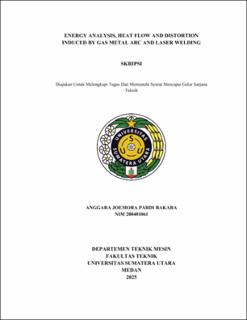Energy Analysis Heat Flow and Distortion Induced By Gas Metal Arc And Laser Welding
Energy Analysis Heat Flow and Distortion Induced By Gas Metal Arc And Laser Welding

Date
2025Author
Bakara, Anggara Joemora Pardi
Advisor(s)
Ambarita, Himsar
Metadata
Show full item recordAbstract
This study investigates angular distortion and thermal efficiency in welded
joints through Finite Element Method (FEM)-based Virtual Manufacturing (VM)
simulation and experimental validation. Two types of welding processes are analyzed:
Gas Metal Arc Welding (GMAW) applied to a T Joint and laser welding applied to a
Butt Joint, both using low-carbon steel S235 as the base material. The numerical
simulations are conducted using Ansys ACT Welding Distortion and Ansys APDL,
employing Goldak’s Double Ellipsoidal and Gaussian Cylindrical heat source models,
respectively. Experimental validation is carried out using robotic welding systems,
ABB IRB 2400/16 for GMAW and a TRUMPF robotic arm for laser welding, combined
with high-precision measuring instruments such as Coordinate Measuring Machines
(CMM) and Zeiss Calypso scanners. The simulation results are compared to
experimental data to evaluate accuracy in predicting heat flow and angular distortion.
The findings show that the FEM-based VM tools are capable of predicting angular
distortion within a relative error range of 4.3% to 9.9% for T Joint and 9% to 31% for
Butt Joint. Moreover, Ansys APDL demonstrated faster computational efficiency and
its capability for deeper mechanical analysis is attributed to the flexibility in defining
and customizing simulation parameters. In contrast, Ansys ACT offers simplified heat
source models and consistent geometric representations that yield sufficiently accurate
results, validating the use of simulation as a planning tool in the design and
manufacturing of welded structures. This research contributes to enhancing
simulation-based welding optimization and offers future potential for real-time
process integration and intelligent manufacturing applications.
Collections
- Undergraduate Theses [975]
